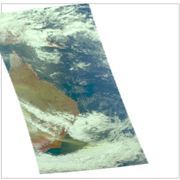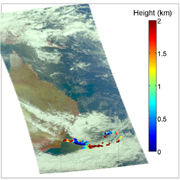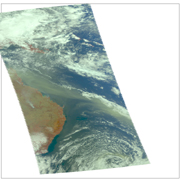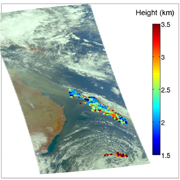 |  |  |  |
Figure 1
Sept. 22 | Figure 2
Sept. 22 | Figure 3
Sept. 24 | Figure 4
Sept. 24 |
Click on individual image for larger viewA major dust storm moved across the eastern and northeastern regions of Australia Sept. 22-24, 2009, out towards the Pacific. The Atmospheric Infrared Sounder (AIRS) instrument on NASA's Aqua satellite was able to detect some of the dust as it moved across the continent. By modeling the changes in the observed brightness temperature for AIRS spectral channels that are affected by dust, an estimate of the amount of dust in the atmosphere can be made. In Figure 2, taken at 03.40 UTC on Sept. 22, 2009, the peak loading close to the coast is estimated to be about 2 grams of dust per square meter. This plume is the one that turned Sydney as red as Mars. The dust from this storm subsequently blew eastward across the South Pacific, and became caught up in a cyclone, as seen in Figures 3 and 4. Depending on prevailing winds, the dust may travel as far as South America. Images in Figures 1 and 3 were taken on Sept. 22nd and 24th, respectively. Images in Figures 2 and 4 show the height of the dust plumes derived from the AIRS data.
Dust storms can wreak havoc with transportation and create health concerns, among their many effects. They also reduce the amount of outgoing longwave radiation. Each year, in a similar fashion, the dust from storms originating in Central and West Africa can be transported as far away as the Amazon.
About AIRS
The Atmospheric Infrared Sounder, AIRS, in conjunction with the Advanced Microwave Sounding Unit, AMSU, senses emitted infrared and microwave radiation from Earth to provide a three-dimensional look at Earth's weather and climate. Working in tandem, the two instruments make simultaneous observations all the way down to Earth's surface, even in the presence of heavy clouds. With more than 2,000 channels sensing different regions of the atmosphere, the system creates a global, three-dimensional map of atmospheric temperature and humidity, cloud amounts and heights, greenhouse gas concentrations, and many other atmospheric phenomena. Launched into Earth orbit in 2002, the AIRS and AMSU instruments fly onboard NASA's Aqua spacecraft and are managed by NASA's Jet Propulsion Laboratory in Pasadena, Calif., under contract to NASA. JPL is a division of the California Institute of Technology in Pasadena.
More information about AIRS can be found at http://airs.jpl.nasa.gov.

